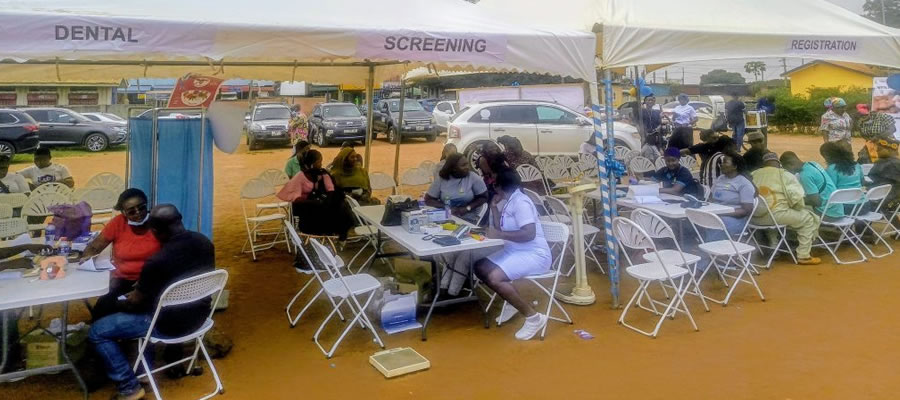

Literacy and Education
Literacy and Education are an important aspect of societal development and forms the foundation of individual advancement and self-actualization. While literacy is the ability to read and write, education is viewed as the process of acquiring knowledge, skills, values and attitudes to fully develop individual capacities for societal wellbeing.
In the 2010 PHC, questions on literacy were posed to persons 11 years and older. Questions on education on the other hand were posed to persons 3 years and older. The questions on education were on school attendance (past and present), educational level attained and grade/form/class completed at that level of education.
Literacy
Figure 3.2 shows that a total of 80,121 persons representing 91.3 percent of the population 11 years and older in the Municipality are literate in at least one language, while the non- literate population constitute 8.7 percent. Five out of every 10 persons (55.4%) could read and write in English and Ghanaian language. Also, about seven out of every 10 persons (67.6 percent) who were 65+ could read and write in English and Ghanaian language.
The population who could read and write in both English and French, and English, French and Ghanaian language are 1.0 percent and 3.0 percent respectively. The results further show that the number of non-literate females (5,694) is about three times more than that of the males (1,921). Similarly, female literate population (39,876) in the Municipality is slightly less than their male counterparts (40,245).
Table 3.9 shows the population 11 years and older who are literate in one language or another by sex and age. With the exception of population between the ages of (11 – 14 years) which has about half ( 50.8%) being literate in English only, the other age categories have at least 53.9 percent being literate both the are literate in English and Ghanaian languages. Particularly, persons aged between (60- 64) years have the highest (68.9%).
Among the various languages of literacy, relatively lower proportions of population in the various age groups are literate in both English and French only, with the least proportion of 0.5 percent belonging to (60-64) year group. The foreign migrant population in Ghana may have accounted for the lower proportion in literacy in English and French.
It is evident from the Table that, similar characteristic of language literacy can be observed among different age groups for each of the sexes. However, the distribution for male category are higher compared with that of the females For persons 65 years and older living in the district, out of a total population of 7,125 more than half are non-literate. The high proportion of non-literate persons among this age group may be due to sight related problem attributable to old age and majority (75.7%) of this population is females.
Table 3.10 provides information on population 3 years and older by level of education, school attendance and sex. Out of the 38,150 persons enumerated as currently in school, 36.9 percent are at the primary level, 16.9 percent were at the JSS/JHS level while 13.7 percent are at the Senior High School level. With regards to those who have been to school in the past (57,731), almost on-quarter (24.0%) had attained JSS/JHS level of education, while about one-fifth (18.4%) have Middle school certificate, SSS/SHS (15.1%) and Tertiary (16.0%).
For the sexes, though there is an even distribution of persons who are currently in school, with the exception of nursery, kindergarten and SHS the proportions of female population for the various levels of education are slightly higher than that of the males. Particularly, 38.1 percent of the females who are currently in school are in the primary school, while 35.7 percent is the case for the males. In terms of information on past school attendance, the record is again in favour of females, dominating at all levels of education except at the secondary level (SHS/SSS). For instance, the results show that more than one-quarter (25.7% ) of the females ended their education at the JHS/JSS levels, while for the males (22.3%). than (Table 3.9).
School Attendance
Figure 3.3 displays school attendance by sex of the population in the Municipality. Generally school attendance is in favour of the male population in the Municipality. For those who are in school, the proportion of the males (37.7%) is higher than that of the females (35.4%). The same characteristic is observed with the population who has been to school in the past, (57.6% against 53.2%). A relatively higher proportion of the female population than that of the male population in the Municipality has never been to school in the past (11.4% against4.7%).
Date Created : 12/5/2017 4:11:12 AM









 facebook
facebook
 twitter
twitter
 Youtube
Youtube
 +233 593 831 280
+233 593 831 280 0800 430 430
0800 430 430 GPS: GE-231-4383
GPS: GE-231-4383 info@ghanadistricts.com
info@ghanadistricts.com Box GP1044, Accra, Ghana
Box GP1044, Accra, Ghana